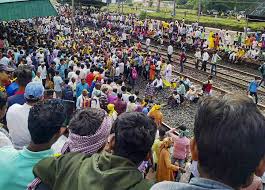Kurmi Community : Protest

Defying prohibitory orders, Kurmis began their rail blockade at various stations in Jharkhand recently to press demand for a ST status for the community and inclusion of the Kurmali language in the Eighth Schedule of the Constitution.
- Kurmis, also known as Kunbi, are a Hindu farming caste in India and Nepal.
- The term “Kurmi” is believed to be derived from the Sanskrit word “Krishi,” which means agriculture.
- They are mostly found in the lower regions of the Indo-Gangetic plains, especially southern regions of Awadh, eastern Uttar Pradesh and parts of Bihar.
- It is believed that the Kurmis were descendants of ancient Kshatriya warriors who practiced agriculture.
- There are several sub-groups within the Kurmi caste called gotras. Some common Kurmi gotras include Chandel, Chauhan, Solanki, Tomar, Baghel and Sengar.
- The Kurmis came to be known for their exceptional work ethic, superior tillage and manuring, and gender-neutral culture, bringing praise from Mughal and British administrators alike.
- The Kurmali language, primarily spoken by the Kurmi community in Bihar, Jharkhand, and Odisha, is part of the Indo-Aryan language family.
- Nowadays, Kurmis are placed in the Other Backward Class (OBC) category in most parts of India.
- However, Kurmis tend to believe that they have tribal roots and have long been demanding Scheduled Tribe (ST) status for their community and inclusion of the Kurmali language in the Eighth Schedule of the Constitution.




